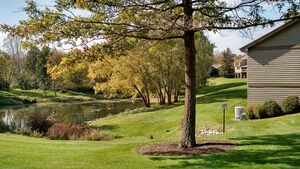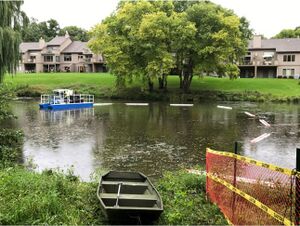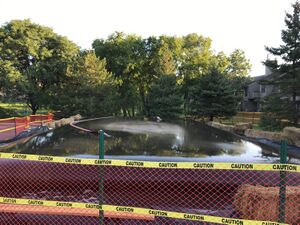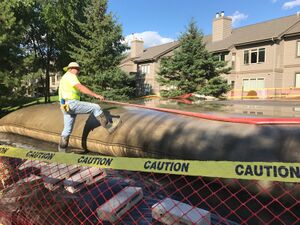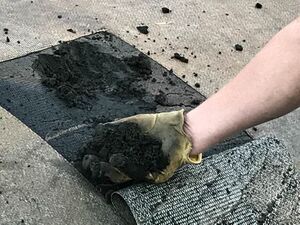
Sediment Dewatering and Disposal Case Study: City of Eden Prairie Timber Creek Townhomes Stormwater Pond Sediment Removal and Disposal
Stormwater wet ponds are one of the most widely used practices to capture particulate pollutants in stormwater runoff in Minnesota. Stormwater ponds are designed to capture particulates in stormwater by routing stormwater through the pond and settling out suspended solids and associated pollutants. Because the ponds are designed to accumulate sediment to protect downstream water bodies, they will slowly fill in and lose their original capacity to remove suspended sediments. Consequently, stormwater ponds often require excavation to remove accumulated sediments and restore the pond’s original capacity. The settling process sometimes results in pond sediments high in heavy metals and Polycyclic Aromatic Hydrocarbons (PAHs) which require special handling and disposal. Pond excavation can be highly intrusive to local landowners often damaging local landscaping or requiring mature tree removal. For this reason, there is a need for less intrusive excavation methods.
The Timber Creek Townhomes, located in north central Eden Prairie, included a stormwater pond to protect downstream water bodies from increased particulate runoff from impervious surfaces associated with the development. In 2012, the pond was surveyed as a part of the City’s MS4 (Municipal Separate Storm Sewer System) program and determined to have lost capacity because of particulate settling since construction. The City proposed to remove 800 cubic yards of sediment to restore the settling capacity of the pond. Pond sediments were determined to have high levels of metals and PAHs requiring careful handling of the sediments and disposal at a facility designed to accept contaminated sediments. The City initiated their internal planning process including department staff from utilities, engineering, water resources, park maintenance and streets to determine the best approach for removing the contaminated pond sediments. As a result of the planning process, the City recognized that the pond would be difficult to access for traditional excavation methods without significant damage to the surrounding property and landscaping including large tree removal. So, the City decided to use a dredging system where pond sediment is transported as a sludge from the pond to sediment dewatering bags located for easy access to transport the dredged sediments to the required disposal location.
Sediment removal for the Timber Creek Townhomes pond was accomplished by dredging the pond and pumping the sediment slurry to the dewatering bags in a designated dewatering area. The dredge utilizes a self-propelled, submersible suction head with a high-volume pump to transport the sludge to the desired dewatering location. While the dredge was able to access most required areas of the pond, dense willow roots prevented access to some areas close to the shore. The designated sediment dewatering area for this project only required the removal of three trees, minimizing the impact to local landscaping. The sediments were dewatered using porous dewatering bags where water can leach out while sediments remain behind, returning the water to the stormwater pond. Once the sediments are dry, they were transported to the required disposal location.
The project was initiated on August 21, 2017 and completed on October 19, 2017. The project took longer than originally anticipated with sediment dewatering requiring more time than planned. The selected sediment dewatering area required stacking the dewatering bags, slowing the dewater process. In the future, a larger sediment dewatering area including more dewatering bags will be considered. Another challenge for the project was access for launching the dredge which had to be lifted into the pond by crane. The City was able to use restoration mats to prevent damage to local lawns and landscaping while still launching the dredge into the pond.
Overall, the project was able to successfully remove 800 cubic yards of contaminated sediments while minimizing the damage to local landscaping and pumping the sediment to an easy access location for transportation to the disposal site. This approach can help mitigate some of the damage typically associated with excavating a pond and improve access options for difficult to reach ponds in need of excavation.
For more information related to Sediment Dewatering and Disposal project, contact Leslie Stovring, Water Resources Coordinator at the City of Eden Prairie: lstovring@edenprairie.org.
Project Location: Eden Prairie, MN just south of Ellerdale Lane
Completion Date: October 19, 2017
Entities Involved:
- Project Assessment and Planning: City of Eden Prairie Departments of Utilities, Engineering, Water Resources, Park Maintenance and Streets.
- Sediment Dredging, Dewatering, and Disposal: Aquatic Restoration Service, LLC
Project Cost: Total Project Cost: $126,000; Consultant/Design Cost: $40,000 (includes $2,000 sediment testing cost); Contractor Cost: $85,000 (includes $10,000 disposal fee)
Quantitative Outcomes:
- Sediment Removed: 800 cubic yards.
- TSS reduction: 330 pounds/year
- TP reduction: 1.0 pounds/year
This page was last edited on 22 July 2022, at 23:45.

